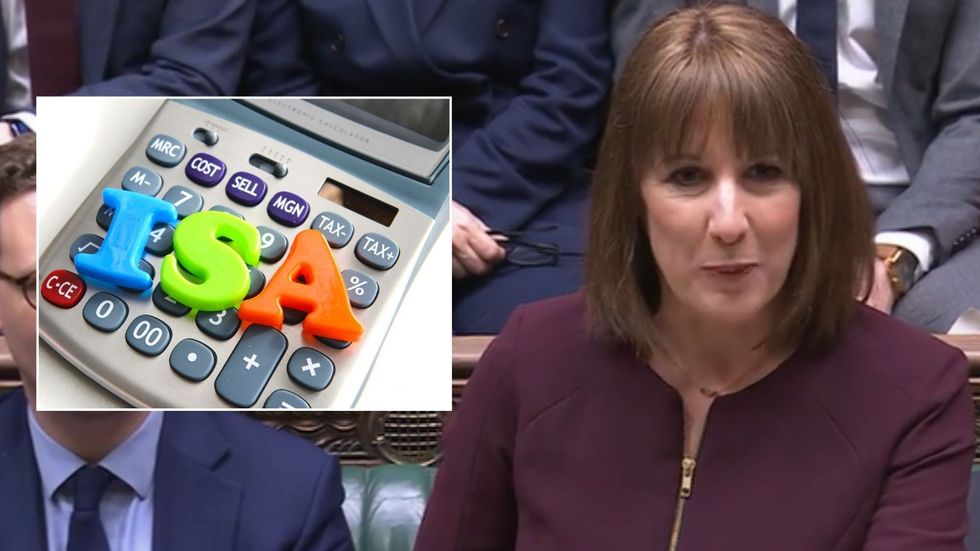‘Vital lifeline!' Warning over possible cut to £20,000 ISA allowance

Experts say removing the full ISA limit could hit retirees, first-time buyers and inheritance recipients
Don't Miss
Most Read
Latest
Uncertainty surrounds the fate of the £20,000 cash ISA allowance as the Budget approaches, with potential changes not yet ruled out.
This threatens not just affluent savers but ordinary Britons who depend on the full allowance during crucial life moments.
HMRC figures reveal that 1.46 million people maximised their cash ISA contributions in 2022/23, while £69.5billion flowed into these accounts during 2023/24.
The average contribution stood at £6,993.
TRENDING
Stories
Videos
Your Say
Sarah Coles, head of personal finance at Hargreaves Lansdown, said: "There are all sorts of people for whom the £20,000 cash ISA allowance is a vital lifeline at key moments during their life."
She emphasised that even those on modest incomes who struggle financially may require the complete allowance when unexpected lump sums arrive.
Retirees face particular challenges when transitioning from employment, as their emergency fund requirements expand significantly.
While working individuals typically maintain three to six months of essential expenses in accessible accounts, pensioners require between one and three years of spending reserves.
Based on monthly essentials of £1,500, this translates to holdings between £18,000 and £54,000.
Basic rate taxpayers encounter tax implications when savings exceed £22,000 at present interest rates.
Many retirees utilise tax-free pension withdrawals to establish these crucial safety nets.

Uncertainty surrounds the fate of the £20,000 cash ISA allowance
| GETTYMs Coles said: "Even someone on a relatively modest retirement income can benefit enormously from the full cash ISA allowance."
Without the complete £20,000 annual limit, pensioners would struggle to shelter these necessary funds from taxation, particularly when receiving pension lump sums in a single payment rather than accumulating savings gradually over multiple years.
Property downsizing forms part of retirement planning for 29 per cent of people, according to Hargreaves Lansdown research, with average releases of approximately £300,000 based on Savills data.
These funds often supplement retirement income or cover healthcare and social care expenses.
While longer-term money might suit investment strategies, those dependent on this income without financial flexibility may keep substantial amounts in cash.
Latest Development
 ISA reform is still on the cards | GETTY/GBNEWS
ISA reform is still on the cards | GETTY/GBNEWSCare funding presents another scenario requiring significant liquid assets.
Those without immediate needs annuities typically maintain cash reserves for care expenses.
Annual care costs frequently reach £30,000, pushing even basic rate taxpayers beyond tax thresholds.
The £20,000 ISA limit provides essential protection for these vulnerable savers managing healthcare expenses.
Young property buyers face mounting challenges when family members provide financial assistance for deposits.
Research indicates that 40 per cent of younger purchasers receive monetary support from relatives, typically arriving as single lump sum payments.
With first-time buyer deposits averaging £68,154 in England, these gifts substantially exceed the £4,000 annual Lifetime ISA contribution limit.
Recipients often hold these funds in cash while arranging property purchases.
Such substantial sums push even basic rate taxpayers into taxable territory, making the full cash ISA allowance vital for protecting deposits.
Ms Coles explained that while Lifetime ISAs offer tax-free savings plus government bonuses for qualifying buyers, family gifts arriving in bulk surpass these limits.
Without the £20,000 cash ISA allowance, aspiring homeowners would face unnecessary taxation on deposits accumulated through family generosity, adding further barriers to property ownership.
Inheritance beneficiaries often require substantial time to process both emotional and financial decisions following their windfall.

Recipients planning pension contributions face annual allowance restrictions of £60,000 or their income, whichever proves lower
| GETTYSome establish emergency savings accounts, while others temporarily hold funds pending property renovations that may require more than twelve months for planning permissions and builder availability.
Recipients planning pension contributions face annual allowance restrictions of £60,000 or their income, whichever proves lower.
This necessitates spreading contributions across multiple years, keeping inherited money in cash meanwhile.
Ms Coles said that beneficiaries may feel "overwhelmed by the changes in their life" and prefer maintaining cash holdings temporarily until emotionally prepared for investment decisions.
Significant sums remaining in cash for extended periods create tax liabilities without ISA protection.
More From GB News











